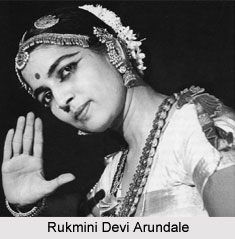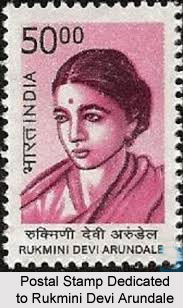 Rukmini Devi Arundale had a many-faceted personality. She had the vision of a poet and looked at the beautiful side of things. It was this sense of beauty that made her life a thing of joy. She tirelessly spread the message of Indian art and heritage within the country and outside. She was not only a famous dancer but also an animal lover and a champion of vegetarianism. She was nominated twice to India`s Upper House of Parliament, the Rajya Sabha, where she pushed and got passed the Bill for Prevention of Cruelty to Animals. Morarji Desai suggested her name for the Office of President of the Indian Republic. It was she who brought Maria Montessori to India and organized her public talks and set up the first Montessori kindergarten in India. Rukrnini Devi Arundale died on 24th February 1986. In 1987, government introduced postal stamp for the sake of her recognition.
Rukmini Devi Arundale had a many-faceted personality. She had the vision of a poet and looked at the beautiful side of things. It was this sense of beauty that made her life a thing of joy. She tirelessly spread the message of Indian art and heritage within the country and outside. She was not only a famous dancer but also an animal lover and a champion of vegetarianism. She was nominated twice to India`s Upper House of Parliament, the Rajya Sabha, where she pushed and got passed the Bill for Prevention of Cruelty to Animals. Morarji Desai suggested her name for the Office of President of the Indian Republic. It was she who brought Maria Montessori to India and organized her public talks and set up the first Montessori kindergarten in India. Rukrnini Devi Arundale died on 24th February 1986. In 1987, government introduced postal stamp for the sake of her recognition.
Early Life and Marriage of Rukmini Devi Arundale
Rukmini Devi Arundale was born at Madurai on February 29, 1904, during the auspicious Mahamaham Festival. Rukmini Devi was one of eight children of her parents. Her father Nilakantha Sastri belonged to an orthodox Brahmin family of Sanskrit scholars. During her childhood, she had fleeting glimpses of Bharatanatyam at the Navaratri festival organized by her father for the Maharaja. In those days, dance was an integral part of temple festivals. Rukmini Devi Arundale was married to George Arundale, a foreigner and a leading member of the Theosophical Society. The marriage helped her to get exposure to foreign audiences and also to widen her mental horizon.
Career of Rukmini Devi Arundale
Rukmini Devi Arundale learnt Sadir, the art of the devadasis from Mylapore Gowri Amma and Pandanallur Meenakshi Sundaram Pillai. In 1935, she gave her first public performance at the "Diamond Jubilee Convention of the Theosophical Society". First she brought Sadir to global attention by removing the extraneous sringaar and erotic elements from the dance. Soon she changed the face of the dance, by introducing musical instruments, like violin, lighting design elements, and innovative costumes, and jewellery inspired by the temple sculptures. Then she approached noted classical musicians and artists, for collaboration. Then she created some of the pioneering dance dramas-based on Indian epics like Ramayana and Gita Govinda.
 Foundation of Kalakshetra
Foundation of Kalakshetra
In the year 1936, Arundale along with her husband established Kalakshetra `The Temple of Arts`. Training in Kalakshetra was perfect. Rukmini Devi was a purist who never compromised on the quality of classical arts. There were great masters like Papanasam Sivan and Mysore Vasudeva Acharya as the staff of Kalakshetra. The teaching was in Gurukula style. Most of the classes were in the open, under the shade of the great banyan trees of Adyar. It was like the Shantiniketan, West Bengal of Rabindranath Tagore. Kalakshetra will remain as a living monument to her. Besides Kalakshetra, she found schools in memory of Annie Besant.
Honours to Rukmini Devi Arundale
The honours which have been given to the legendary dancer are:
Padma Bhushan-1956
Sangeet Natak Akademi Award-1957
Desikothama-1972
Sangeet Natak Akademi Fellowship-1967
Prani Mitra-1968
Queen Victoria Silver Medal, Royal Society for the Prevention of Cruelty to Animals, London
Kalidas Samman-1984)
Addition to the roll of honour by The World Federation for the Protection of animals, The Hague
Honorary Doctorate, Wayne State University, United States
Scrolls of Honour, County and City of Los Angeles



















